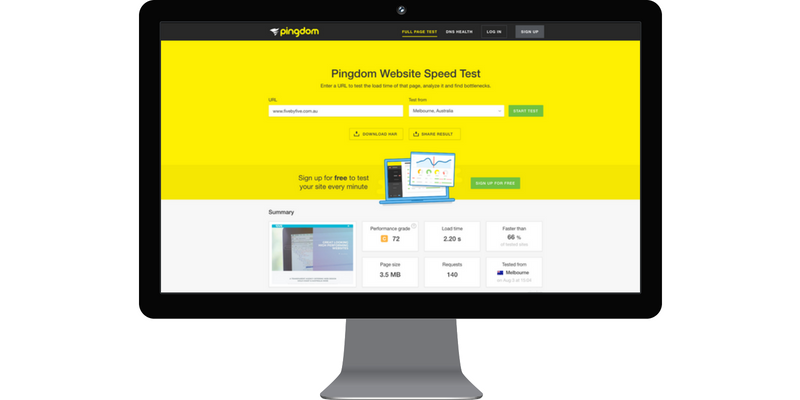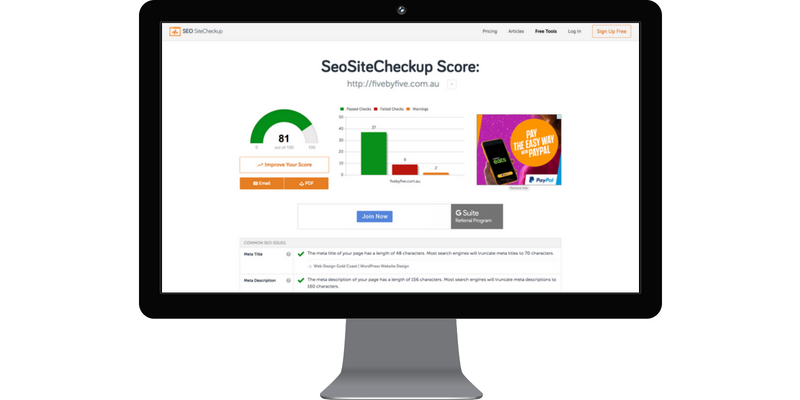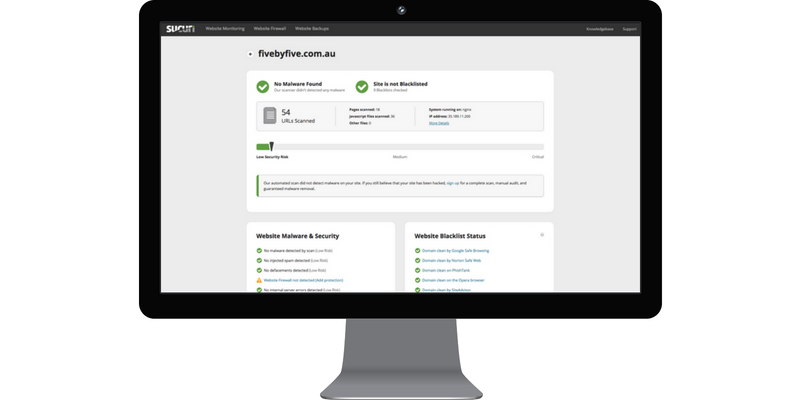Suffering website fatigue?
Don’t know how to navigate the back or front end of your business website?
Bamboozled by load speeds, SEO, heat mapping, and analytics?
Take heart. You’re not alone.
Most busy business owners are rowing the same boat. Juggling multiple hats, becoming captain of your website too, can feel like you’re paddling to a distant shore – you never reach.
It’s no longer enough to be on top of your business game. Business owners wanting to kick marketing goals must now know a thing or three about website operations too. Whether you’re self-taught, or if you’ve hired help, it pays to know at least enough to ask the right questions.
And while this can seem daunting at first, getting inside your website isn’t as scary as you think. With a few healthy hacks, website wunderkind you may not be, however you will feel more confident your ship’s sailing in the right direction.
Check out these healthy hacks and prime your website for peak performance.
#1 Looking sharp, sailor! Knowing if your website looks good on all devices
Thanks to technology, we’ve become very visual beings. We – and our customers – expect a website to work as well as look good.
While visual appeal is subjective, there’s no doubt good design, beautiful images, dynamic video all play a role in the way customers respond. That’s why it’s important to take care your business website looks the part on every device – mobile or desktop.
All elements should come together so your customer has an experience of connecting with you online, regardless of where that occurs. As searches increasingly move to mobile, checking out the way your site shapes up on the myriad of devices and search engines can be a challenge, but not an insurmountable one.
Fortunately, simple solutions abound.
Our go-to tool for browser testing is BrowserStack. Allowing you to perform interactive web-based testing on 1200+ browsers and a range of Android and iOS mobile devices, BrowserStack can save time and heartache. With BrowserStack you can test your mobile website on different devices with different screen sizes, running different operating systems.
They offer a free trial, but the paid version is where you’ll find the gold. And it’s worth the investment. Because of its functionality to test so widely, BrowserStack is ideal for any business owner with an online shop. Nervous store owners can run tests that give confidence your business will be looking good, wherever it shows up.

Not relying on e-commerce store sales? Save your cash and check out your website on XRespond. A testing tool like BrowserStack, XRespond is free and allows business owners to test their site’s responsiveness on different devices. Using it is simple. Type in your web address and with one click, XRespond will automatically display the website on multiple virtual devices.
Looking good? You bet.

#2 Desktop v. Mobile. How you doin’?
With Google’s recent announcement that mobile is where it’s at, business owners need to wise up to how their website is performing on desktop and mobile.
Fortunately, the big G makes this easy with Google PageSpeed Insights. Claiming to “make your web pages fast on all devices”, PageSpeed Insights analyzes web page content and makes suggestions about how the speed of a particular page can be improved. It reports on two metrics: First Contentful Paint (FCP) and DOMContentLoaded (DCL). In layman’s terms, this means your page will be scored low, medium or good for speed and optimization.
PageSpeed Insights doesn’t just give you a score; it makes suggestions for optimization too. Check out more PageInsights details here or on the PageInsights FAQ page.

#3 So hot right now. Knowing what people are doing on your website
Want to crack the code of activity on your website? Try Hotjar. Marketed as an all-in-one tool for website analytics and feedback, Hotjar is the way to understand what visitors are doing when they land on your mobile or desktop website.
Why is this important? Well, it allows you to visualize site visitors’ behaviour, by learning what they want, care about, and do – all from the way they click, tap and scroll. Hotjar also incorporates nifty functionality like recordings of visitors movements on a page and where visitors might be dropping off before sale conversions.
Try Hotjar for free, but expect to pay if you’re after all its functionality.

#4 How are your stats? Getting smart with Google Analytics
Google Analytics is another tool designed to help business owners understand their customers and what they do on their website.
In addition to providing detailed data on changes in website performance, emerging trends and other opportunities, Google Analytics is a great tool for other tasks. With the ability to generate reports on your market, advertising, purchasing, conversions, user-flow, it’s possible to really know your customer.
And while it may take some navigating – and a little help – to fully understand Google Analytics’ capability, it will be well worth the investment. As commerce moves to mobile, extracting this kind of data is even more important for business owners wanting to optimize their website.
You might love the detail and want results every day. Or maybe you’re happy with monthly reporting. Either way, reports can be tailored accordingly and keep you on track to kick your business website performance goals.

#5 How quick are you? Check page load speeds with Pingdom
We’ve become an impatient bunch, haven’t we?
Thanks to faster internet speeds, we just expect every website to load quickly. And when they don’t? Well, let’s just say people won’t hang around for long.
But what if it’s your website’s the slow one? Hmm.
Time to check out Pingdom. Allowing business owners to test the load time of any url, and then analyse it, Pingdom is a handy tool for finding the choke points when it comes to the speed at which a page loads.
By examining all parts of a page (file sizes, load times and other details), it’s possible to tweak and refine the website’s performance. Among other features, Pingdom measures web page performance against best practice and provides tips on how to speed things up.
Offering a 14 day free trial, Pingdom is a smart way to stay on top of your site’s load speed – a big factor for keeping customers happy – and on your website. Just make sure you test from “Melbourne” location if you’re Australian based.

#6 How’s your website’s SEO performance? Getting search engine savvy with SEO SiteCheckUp
Looking for a way to get SEO savvy? SEO SiteCheckUp is a tool we recommend to analyse and monitor SEO.
Providing a whole toolbox of resources for business owners, SEO SiteCheckUp will help analyze SEO issues, track changes, understand competitors’ profile, and produce straightforward reports real business owners can understand.
No more confusing SEO talk? Well, we can’t promise that, however tools like SEO SiteCheckUp will give business owners the confidence to ask questions and make adjustments about this important aspect of website performance.
Like Pingdom, SEO SiteCheckUp offers a free 14 day trial. It’a the perfect way to play around with the features and see how it could work for you.

#7 Security compromised? Becoming site safe with Sucuri SiteCheck
Once your great looking website’s up and running beautifully, it’s time to turn attention to site security. It’s no myth. Hackers are out there looking bring down unsuspecting business owners. Don’t be one of them!
We install, and encourage our customers to subscribe to, website malware and security scanner tools like Sucuri SiteCheck. Sucuri’s big claim is it will keep your website clean, fast and protected, by checking for known malware, blacklisting status, website errors, and software that’s past its expiry date.
For $199.00 (that’s USD), business owners can take advantage of Sucuri’s basic plan, which includes a guaranteed 12 hour response time, a website scan every 12 hours, and a Let’s Encrypt SSL Certificate (vital for protecting sensitive information).
Website security is a bit like insurance: necessary, but ideally never used. Tools like Sucuri SiteCheck provide the peace of mind every business owner needs if they’re relying on a website for business.

The Wrap
We use these tools, and many others, on our clients’ websites, running periodic checks and updates. The thing to remember with websites – and the platforms, tools, and environment in which they operate – is things are constantly changing. Staying on top of things can be hard, so if you feel like you could do with support, reach out! We’re happy to talk through these seven tools and how they form part of our ongoing website support packages.




